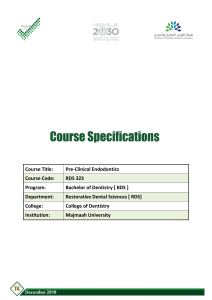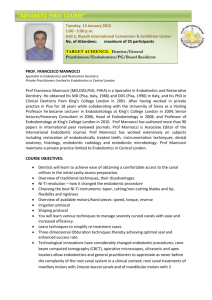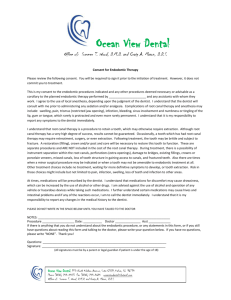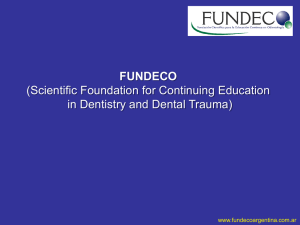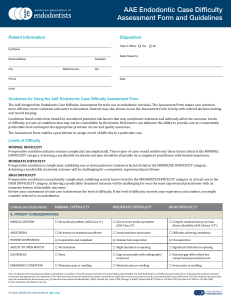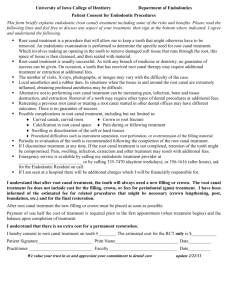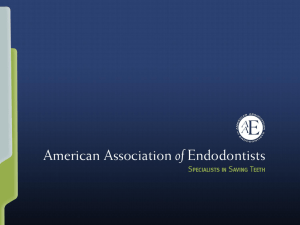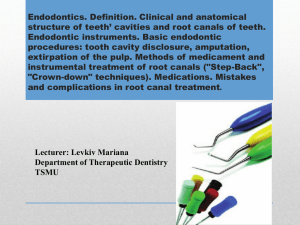Endodontia
advertisement
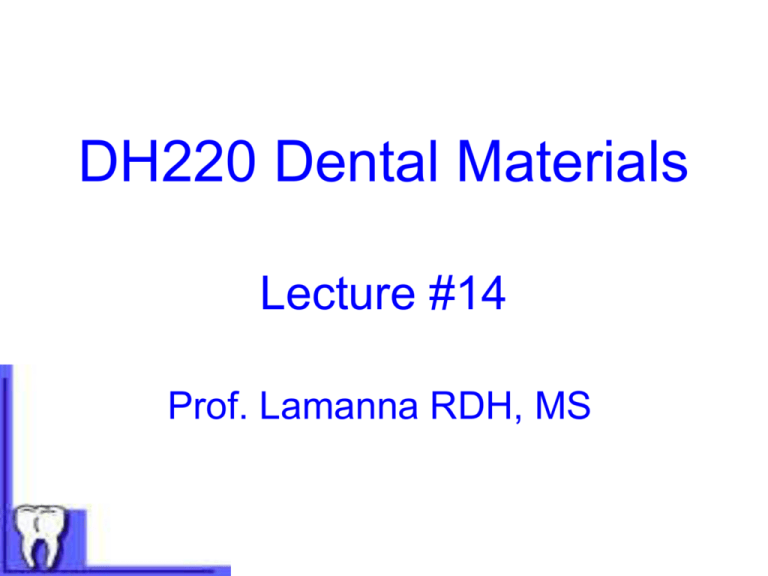
DH220 Dental Materials Lecture #14 Prof. Lamanna RDH, MS Endodontia Endodontia Definition: the specialty in dentistry concerned with the etiology, diagnosis, prevention , and treatment of diseases and injuries of the dental pulp and associated periradicular tissues. Objectives of Endodontic Therapy • To provide a clean canal – the aim is to produce a reduction of bacteria to a non-pathogenic level. • To provide an “apical seal” – this prevents the ingress of fluids which will provide nutrients for canal bacteria and also prevents irritants leaving the canal and entering the periapical tissues. • Indications: Necrotic pulp, irreversible pulpitis, fractured apical third, irreversible trauma, avulsion • Contraindications: Reversible pulpitis, poor perio prognosis, pt chooses extraction Endodontic Diagnosis • Subjective: patient reports – – location, intensity, duration • Objective: clinical evaluation – – dental history, radiographs, clinical exam Clinical Examination • Control teeth – adjacent and contra lateral to observe level of response. • Percussion – tapping • Palpation – pressure • Thermal sensitivity – applying hot and/or cold • Mobility • Transillumination – detection of fractures • Depth of decay • Electronic pulp testing with vitalometer Wilkins p. 273 – 276 Electronic pulp testing with vitalometer Endodontic instruments • Endodontic explorer – locates canal openings • Endodontic excavator – removes deep coronal pulp tissue • Broaches – remove bulk of pulpal tissue • Files – smooth, shape, and enlarge canal • Irrigation solution – sodium hypochlorite • Paper points – absorb irrigating solution and dry canal • Spreaders & pluggers – obturate & condense the canal with sealer and gutta percha Endodontic Filling Materials: An “ideal” endodontic filling material should meet the following requirements: • it should seal the canal laterally as well as apically • it should not shrink after insertion • it should be impervious to moisture • it should be bacteriostatic • it should not irritate periradicular tissue • it should be biocompatible No one material meets all these requirements; continual research endeavor to find the ideal obturating material. 1. Endodontic Sealer – cement used to obtain an antibacterial seal at the apical foramen; fills the space between the gutta-percha (obturating point) and the wall of the canal, producing an antibacterial seal. Composition: Three groups – - zinc oxide-eugenol cement - resin-based - calcium hydroxide-based cement 2. Gutta Percha Points – most frequently used material (rubber) to obturate the canal after completion of tx. * Also used: silver points – good bactericidal effect; but tend to corrode and stain adjacent soft tissues. Composition: gutta percha – rubber zinc oxide – filler metal salts – radio-opacifier wax or resin – plasticizer Overview of Endodontic Therapy • Administration of local anesthetic • Isolation of operating field – mandatory use of dental dam – WHY? • • • • Access preparation Cleaning and shaping the canals Obturation – sealing and filling the canal(s) Post –op - permanent restoration placed ECC paper dental charting • Draw a line through all roots & views of the root(s) from the CEJ to the apex of the root. • Add the final restoration: filling, crown, etc. Endodontic failures: what could have happened? • • • • Persistent infection Inadequate instrumentation Inaccessible canals Unsealed lateral canals (accessory canals) • • • • • Severely curved roots Perforation of the canal Fractured roots Extensive root resorption Pulp stones Surgical Endodontics • Apicoectomy – surgical removal of the apex of the root • Apical curettage – removal of pathological tissue around the apex • Retrograde restoration – placed when apical seal is not adequate (gutta percha, amalgam, composite) • Root amputation - removal of one or more roots without removal of the crown • Hemisection - root & crown are cut length wise and removed Before After THE END - Any Questions ???? • Showtime ….. • This is the last teaching class – see you next week for Test #5 on Ortho & Endo … you will also hand in Case Study #3. REVIEW REVIEW TEST #5 ORTHO & ENDO 1.HANDOUTS – ALL OBJECTIVES 2.CHPT 13 – GLADWIN TEXT 3.CHPT 16 & 28 – WILKINS TEXT 4.ORTHO HANDOUTS FROM DM LAB (review diagrams) 5. Remember Edpuzzle.com TEST FORMAT: T/F – 7 M.C. – 27 MATCHING – 13 SHORT ANS. – 4 DIAGRAM IDENTIFICATION – 6 BONUS QUESTION

